[av_slideshow_full size=’no scaling’ stretch=” animation=’fade’ autoplay=’false’ interval=’5′ control_layout=’av-control-default’ src=” attachment=” attachment_size=” position=’top left’ repeat=’no-repeat’ attach=’scroll’]
[av_slide_full slide_type=’image’ id=’60246′ video=” mobile_image=” video_format=” video_ratio=” title=’Archibald Knox
for Liberty & Co.’ custom_title_size=’48’ custom_content_size=’18’ caption_pos=’caption_center’ link_apply=” link=’lightbox’ link_target=” button_label=” button_color=’light’ link1=’manually,http://’ link_target1=” button_label2=” button_color2=’light’ link2=’manually,http://’ link_target2=” font_color=’custom’ custom_title=’#ffffff’ custom_content=’#020202′ overlay_opacity=’0.1′ overlay_color=” overlay_pattern=” overlay_custom_pattern=”]
BY ELIZABETH MCFADDEN
[/av_slide_full]
[/av_slideshow_full]
[av_textblock size=” font_color=’custom’ color=’#ffffff’]
Tudric pewter shelf clock with enameled face and distinctly hammered finish. Image courtesy of Rago Arts and Auction Center, Lambertville, N.J.
[/av_textblock]
[av_section min_height=” min_height_px=’500px’ padding=’large’ shadow=’no-shadow’ bottom_border=’no-border-styling’ id=” color=’main_color’ custom_bg=’#f2f2f2′ src=” attachment=” attachment_size=” attach=’scroll’ position=’top left’ repeat=’no-repeat’ video=” video_ratio=’16:9′ overlay_opacity=’0.5′ overlay_color=” overlay_pattern=” overlay_custom_pattern=”]
[av_one_full first min_height=” vertical_alignment=’av-align-top’ space=” margin=’0px’ margin_sync=’true’ padding=’10px,20px,10px,20px’ border=’1′ border_color=’#eaeaea’ radius=’1px’ radius_sync=’true’ background_color=’#ffffff’ src=” attachment=” attachment_size=” background_position=’top left’ background_repeat=’no-repeat’]
[av_hr class=’invisible’ height=’20’ shadow=’no-shadow’ position=’center’ custom_border=’av-border-thin’ custom_width=’50px’ custom_border_color=” custom_margin_top=’30px’ custom_margin_bottom=’30px’ icon_select=’yes’ custom_icon_color=” icon=’ue808′ font=’entypo-fontello’]
[av_textblock size=” font_color=” color=”]
London department store founder Arthur Lasenby Liberty (1843-1917) was a major influence in the history of modern design, with many of Liberty & Co.’s creations being as important today as they were a century ago.
[/av_textblock]
[av_hr class=’invisible’ height=’20’ shadow=’no-shadow’ position=’center’ custom_border=’av-border-thin’ custom_width=’50px’ custom_border_color=” custom_margin_top=’30px’ custom_margin_bottom=’30px’ icon_select=’yes’ custom_icon_color=” icon=’ue808′ font=’entypo-fontello’]
[av_textblock size=’16’ font_color=’custom’ color=’#686868′]
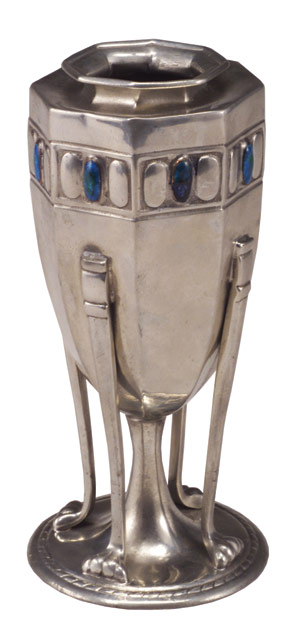
Arthur Liberty’s association with Archibald Knox (1864-1933), one of his most talented designers, brought us Tudric ware – goods crafted from pewter. Knox’s designs were timeless, inspired pieces, taking their inspiration from ancient Celtic patterns, bringing affordable beauty to more homes than ever. Yet, due to Liberty’s strict policy of anonymity, Knox’s name is not to be found on any of the pieces he designed.
The end of the 19th century was rich with the ideas of the Arts & Crafts movement, with its move away from mass-produced goods; and Art Nouveau, drawing its inspiration from nature. It was also fashionable to incorporate traditional styles of individual countries into art and design. In Britain, inspiration was drawn from ancient Celtic symbolism, with its crosses, knots and elaborate interlace patterns. Archibald Knox was chiefly responsible for Liberty & Co.’s role in the Celtic revival, using his talent for design and his deep knowledge of all things Celtic to create household objects steeped in ancient references, yet with designs adapted to more modern tastes. The Cymric (silver) and Tudric (pewter) ranges of goods included functional pieces for the home ranging from clocks to candlesticks. They combined functional, modern design with Celtic inspiration in a blend of object, pattern and shape well ahead of its time.
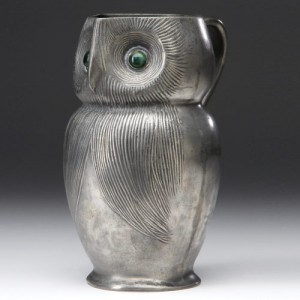
Liberty & Co., the now world-famous department store on London’s Regent Street, was founded in 1875. Starting out with one assistant and one porter, Liberty specialized in fine fabrics and rugs from the Orient. By the 1890s, Liberty & Co. had begun producing its own patterns. As the store fast became the place to shop, it began selling a wider range of items, including furniture and decorative household items under the name Liberty & Co.
From the outset, Arthur Liberty showed a flair for marrying the idea of classical design with new innovations. Going against the rejection of mass-production associated with the Arts & Crafts movement, he employed machinery to produce goods, but insisted on maintaining standards in keeping with the Arts & Crafts principle of finely finished goods. Liberty style became synonymous with great quality and fabulous taste – in Italy, Art Nouveau became known generically as “Stile Liberty.” When interviewed by The Daily Chronicle following his knighthood in 1913, Sir Arthur commented, somewhat drily, that he had become “a mere adjective.”
In 1899, Archibald Knox began to design pieces for the Cymric range of silverware for Liberty & Co., so named to reflect its Celtic-inspired designs. These were some of the finest, most brilliantly designed silverware pieces of the day. Knox’s unique ability to combine beauty and form harmoniously with function was evident in the stunning pieces he created. The most sought-after pieces of Cymric ware attributed to Knox can cost hundreds of thousands of dollars today.
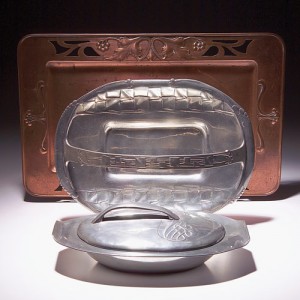
In 1900, with the success of German art pewter in the market, in particular that of J.P. Kayser & Son, Liberty’s commitment to “the production of useful and beautiful objects at prices within the reach of all classes” led to the production of his own Tudric range of pewter ware, presenting competition for Continental manufacturers. Knox submitted designs on a piecework basis, and Liberty oversaw the production of what have become some of today’s most desirable examples of pewterware. Pieces of Tudric ware were given registration marks, a series of digits (presumably the mold or model number) to help prevent competitors from pirating an object, as well as the brand name “TUDRIC.” Many pieces were also marked Liberty & Co. Any attempt to trace a designer using these registrations leads right back to Liberty & Co.
There seems a strong social significance to the production of Tudric ware, as it made great design and beautiful household goods accessible to more people than ever before. Liberty made it his business to produce machine-made goods, but not at the expense of excellence. Much of Liberty’s machine-made Tudric ware has the hammered look of handmade Arts & Crafts metalwork. Many of the finer pieces are embellished with semi-precious stones, abalone, or what Knox called “floating” blue and green enamels.
Knox, who saw himself as a modernist, moving away from tradition towards the abstract, was, it seems, a willing participant in the use of cutting-edge methods of production. Commercially, his association with Liberty distinguishes the Tudric ware range as being groundbreakers in the movement toward mass-produced, high-quality goods. His quiet, unobtrusive nature must have fitted comfortably with Liberty’s strict policy of anonymity with regard to his designers – it seems he was more committed to excellence in design and artistry than any pursuit of personal recognition.
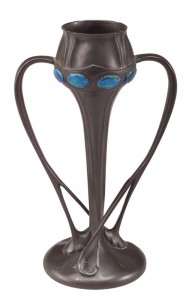
Although his parents were Scottish, Knox was born and raised on the Isle of Man, which nestles in the Irish Sea in the middle of the British Isles. Rich with rugged beauty and ancient Celtic symbolism, the isle and its bond with Knox are unquestionable. He studied Celtic ornament throughout his life, becoming a medallist in 1892 for his study of Historic Ornament, specializing in Celtic design. This knowledge was expressed in the Cymric and Tudric ware designs he produced for Liberty & Co. His creativity was unstoppable; his genius touched textiles, ceramics, silver, pewter and enamels as well as furniture. With his Tudric ware, the design is always integral to the piece, never superfluous.
There is a mystical quality to Knox’s persona; there is little documentation regarding his life and work. Records kept at Liberty’s were destroyed by fire, and much of Knox’s correspondence was apparently lost during the London Blitz. Despite this, and the anonymity of pieces produced for Liberty’s, scholars of his work are able to identify with some authority the distinguished line and design of his hand.
Knox’s enduring and brilliant designs for Liberty & Co. are now in great demand. Actor Brad Pitt is known to be an ardent collector. Said to hold one of the most valuable and extensive Arts & Crafts collections, his passion was fueled when working on location in London, in the 1990s. In 1999 he exhibited pieces from his own silverware collection as part of the Liberty Style exhibition at the Metropolitan Teien Art Museum in Tokyo, which went on to tour Japan. This included one of Knox’s masterpieces, a silver rose bowl, one of the most iconic pieces in the Brad Pitt collection, valued at around $500,000.
In addition, when twins were born to Angelina Jolie and Brad Pitt on July 12 this year, their new son was named Knox Leon Jolie-Pitt. Pitt’s maternal grandfather’s name was Hal Knox Hillhouse, but many believe the name Knox also pays tribute to one of his favorite designers. Indeed, the homepage of the Archibald Knox Society Web site has displayed a message welcoming the Pitt-Jolie’s new arrival.
[/av_textblock]
[av_hr class=’invisible’ height=’50’ shadow=’no-shadow’ position=’center’ custom_border=’av-border-thin’ custom_width=’50px’ custom_border_color=” custom_margin_top=’30px’ custom_margin_bottom=’30px’ icon_select=’yes’ custom_icon_color=” icon=’ue808′ font=’entypo-fontello’]
[av_heading tag=’h3′ padding=’10’ heading='”Knox, who saw himself as a modernist, was a willing participant in the use of cutting-edge methods of production.”‘ color=’custom-color-heading’ style=’blockquote classic-quote’ custom_font=’#020202′ size=’44’ subheading_active=” subheading_size=’15’ custom_class=”][/av_heading]
[av_hr class=’invisible’ height=’50’ shadow=’no-shadow’ position=’center’ custom_border=’av-border-thin’ custom_width=’50px’ custom_border_color=” custom_margin_top=’30px’ custom_margin_bottom=’30px’ icon_select=’yes’ custom_icon_color=” icon=’ue808′ font=’entypo-fontello’]
[av_textblock size=’16’ font_color=’custom’ color=’#686868′]
The work of Archibald Knox has gained him a reputation as a leader in the modern design movement and he has become a major part of the cultural heritage of the Isle of Man. In recognition of this, the Archibald Knox Society was established on the isle in order to “promote the legacy of Archibald Knox” worldwide and allow him “his rightful place in the history of the decorative arts.” The Society’s founder and chairman, Liam O’Neill, is currently working to bring together all known records of all Knox’s work. You can visit the Archibald Knox Society website at www.archibaldknoxsociety.com.
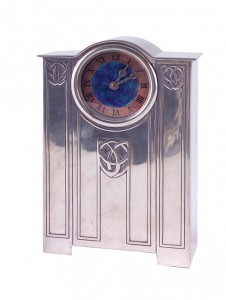
Manx National Heritage is also keen to provide opportunities for people to find out about Knox’s connections with the Isle of Man, and to enjoy the wealth of art and designs produced by Knox. You can visit their website at www.gov.im/mnh/heritage/library/bibliographies/knox.xml.
Visitors to the Isle of Man can visit the Manx Museum, with its extensive collection both of original designs by Knox and examples of jewelry, fabrics, papers, Cymric and Tudric ware, as well as a large number of watercolor paintings.
Tudric ware would continue to be produced for some years after the collaboration between Liberty and Knox ended, but it was during the early period (1899 to approximately 1906, when Knox was designing for Liberty) that some of the most remarkable and vibrant examples were created. Knox remained a bachelor until his death at the age of 69; such was his inexhaustible creativity that it’s small wonder he had no time for marriage.
The significance of Knox’s talent in the story of Liberty & Co. was clearly recognized long after the professional relationship between designer and department store ended, and it was Knox who designed the Celtic-style headstone for Liberty’s grave following his death in 1917. The combination of Liberty’s vision and Knox’s genius still reverberates today, and it seems that, together, they are a seamless combination of talent, genius and pure good taste.
[/av_textblock]
[/av_one_full][/av_section][av_hr class=’invisible’ height=’50’ shadow=’no-shadow’ position=’center’ custom_border=’av-border-thin’ custom_width=’50px’ custom_border_color=” custom_margin_top=’30px’ custom_margin_bottom=’30px’ icon_select=’yes’ custom_icon_color=” icon=’ue808′ font=’entypo-fontello’]
[av_one_fifth first min_height=” vertical_alignment=” space=” custom_margin=” margin=’0px’ padding=’0px’ border=” border_color=” radius=’0px’ background_color=” src=” background_position=’top left’ background_repeat=’no-repeat’][/av_one_fifth]
[av_four_fifth min_height=” vertical_alignment=” space=” custom_margin=” margin=’0px’ padding=’0px’ border=” border_color=” radius=’0px’ background_color=” src=” background_position=’top left’ background_repeat=’no-repeat’]
[av_sidebar widget_area=’SCM – 728×90 – footer’]
[/av_four_fifth]

